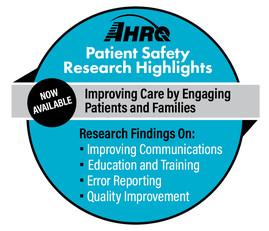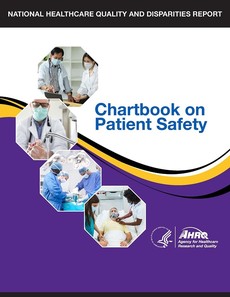| March 13, 2023, Issue #854 In 2019, 7 percent of Black patients, 6.9 percent of American Native patients, 5.9 percent of Asian patients and 4.8 percent of Hispanic patients developed a pressure ulcer, compared with just 4.3 percent of White patients. (Source: AHRQ 2023 Chartbook on Patient Safety.)  A new blog by AHRQ Director Robert Otto Valdez, Ph.D., M.H.S.A., highlights agency investments in diagnostic safety and efforts to reduce fragmentation in our healthcare system. During Patient Safety Awareness Week, Dr. Valdez notes that too often a lack of communication between clinicians and patients and poor coordination within clinical teams can compromise patient care. This fragmentation, heightened by misaligned financial and regulatory incentives, has contributed to the lackluster performance of our healthcare system. AHRQ has issued two Notices of Funding Opportunity to advance diagnostic safety in primary care and continues to support the work of the agency's Diagnostic Safety Centers of Excellence. Access the blog post. To receive all blog posts, submit your email address. |  "Improving Healthcare Safety by Engaging Patients and Families" is the first in a new series of AHRQ publications that summarize the agency's investments in patient safety research as a pathway toward safer care. Research has shown that involving patients, families and caregivers in the planning, delivery and evaluation of care can improve safety and quality. Since 2000, AHRQ has supported 53 patient safety projects related to increasing patient and family engagement. The new research summary includes project findings, which address topics such as communication improvement, education and training, and error reporting and analysis. Future publications in the series will summarize AHRQ-funded safety research in areas such as simulation and teamwork/leadership. |  AHRQ is recruiting primary care practices and long-term care facilities to participate in free 18-month technical assistance projects that aim to make patient care safer. - In the AHRQ Safety Program for Telemedicine, primary care practices will receive one-on-one expert coaching to apply evidence-based strategies to "close the loop" at critical points in the cancer diagnostic process via telemedicine. Register for an upcoming informational webinar and learn how to apply.
- In the AHRQ Safety Program for MRSA Prevention, long-term care facilities will receive evidence-based guidance, expert coaching, webinars, tools and strategies to reduce methicillin-resistant Staphylococcus aureus (MRSA) and other multidrug-resistant organism transmission. Register for an upcoming informational webinar and learn how to apply.
|  AHRQ's newly released Chartbook on Patient Safety underscores the need to address persistent harms caused by poor communication and inappropriate or unnecessary care. The publication, based on data from AHRQ's 2022 National Healthcare Quality and Disparities Report, summarizes trends spanning 2000 to 2020 across key patient safety measures. Findings include: - In 2020, 11.7 percent of non-Hispanic Black adult hospital patients who received a hypoglycemic agent experienced a related adverse event, compared with 4.3 percent of non-Hispanic White patients.
- In 2019, the rate of severe maternal morbidity events was 12.3, 8.7 and 8.2 per every 1,000 delivery hospitalizations non-Hispanic Black, non-Hispanic Asian and Hispanic women, respectively, compared with 6.6 per every 1,000 deliveries among non-Hispanic White women.
- Despite improvements among all races, the percentage of White home healthcare patients who reported that their providers explain things in a way they can understand is an estimated 10 years away from reaching the benchmark of 86.8 percent, and Asian adults are an estimated 20 years away.
Access the chartbook for additional insights into current patient safety challenges. | Identifying interventions to help clinicians manage interruptions could minimize diagnostic errors and improve patient outcomes, according to an AHRQ-funded perspective in the Journal of General Internal Medicine. To date, research on interruptions in diagnostic decision-making has been limited. While offering a model of interruptions to illustrate where interventions can be implemented, the authors considered empirically tested strategies from the fields of healthcare and cognitive psychology that can lay the groundwork for additional research to mitigate effects of interruptions during diagnostic decision-making. They highlighted strategies to minimize the negative impacts of interruptions and strategies to prevent them altogether. Research priorities within the field of diagnostic safety were also proposed. Access the perspective.  When compared with traditional surgical site infection (SSI) surveillance approaches alone, applying a statistical method, known as optimized statistical process control, in addition to traditional surveillance, was more effective at detecting surgical site infection increases and best practice deficiencies. Its use, however, did not lead to a decrease in SSI rates. In an AHRQ-funded study published in EClinicalMedicine, researchers tested use of the statistical process control method to detect SSIs and best practice deficiencies within a large infection control network of 29 U.S. community hospitals in the Southeast for 13 common surgical procedures organized into six clusters: cardiothoracic, gastrointestinal, joint, obstetrics and gynecology, spine and vascular. Researchers found that applying the statistical process control method detected four times as many SSIs, identified best practice deficiencies and allowed SSI rate increases to be detected earlier than traditional surveillance methods. Access the abstract. | | Highlights From AHRQ's Patient Safety Network AHRQ's Patient Safety Network (PSNet) highlights journal articles, books and tools related to patient safety. Articles featured this week include: Review additional new publications in PSNet's current issue or access recent cases and commentaries in AHRQ's WebM&M (Morbidity and Mortality Rounds on the Web). Contact Information For comments or questions about AHRQ News Now, contact Bruce Seeman, (301) 427-1998 or Bruce.Seeman@ahrq.hhs.gov. |
No comments:
Post a Comment